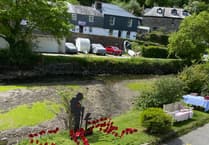AS the tide went out from Millendreath Beach on Monday morning, an historical sight dating back to the Ice Age, which has not been seen for many years, was revealed.
The recent storms had shifted the sand on the normally sheltered bay, and on Sunday night, when the wind veered to a south easterly, enough sand moved to reveal the submarine forest which it is believed was swamped by rising sea levels around 10,000 years ago.
Remnants of the submarine forest are only revealed after the very lowest of tides or extreme weather conditions, so it is a very rare occurrence.
Local historian and retired teacher Jenny Wallis, who lives in the village and who is writing a book about Millendreath, was walking the beach with another resident, Ian Ward, when a dog walker came up to them and said he had seen a sunken boat on the half-tide line.
'On investigating Ian realised it was what is known locally as the "pre-historic forest",' said Jenny.
'It was written about in Thomas Bond's book History of Looe in 1882, which is in Looe Library, so we were aware it existed.
'It is an exciting discovery as it is the first time Ian and I had seen it. We are both volunteers for the Millendreath Owners' Association and the beach is walked every day to litter pick and to make sure the culverts are clear to protect the chalets along the green from flooding.
'The forest grew on the peat bog which still extends up through the Millendreath Valley for about a kilometre. The red fossilised trees I saw were alder, and during the Middle Ages the settlement at Millendreath used alder for smelting the iron which is found in the cliff face.'
The fossilised trees show that, as well as alder, the forest comprised beech, hazel, oak, willow, ash, elm and holly, with yellow iris in the marshes.



